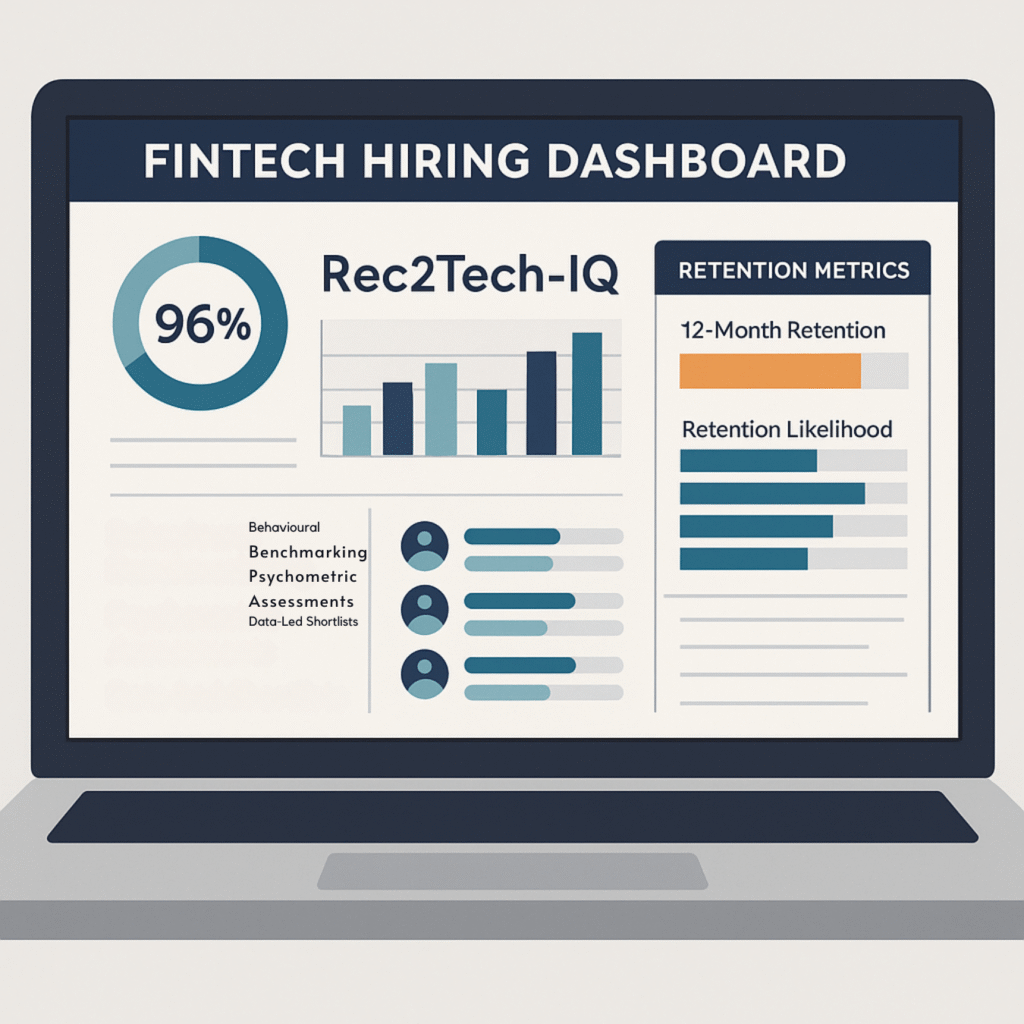Build the Right Team for Your Next FinTech Funding Round

Scaling a fintech business is rarely a straight line. Each funding round shifts your priorities, expands expectations, and reshapes the team you need to deliver the next phase of growth. Yet many companies still hire reactively, filling roles based on short-term demand instead of aligning recruitment with their roadmap, investor expectations, and product trajectory. A strong fintech funding round hiring strategy avoids this cycle. It creates clarity on who to hire, when to hire, and how to secure people who can thrive under new pressures that often increase immediately after capital arrives. Rec2Tech’s data-driven approach shows that scale-ups who plan their talent needs before each round move faster, avoid common hiring mistakes, and build teams that stay beyond the first year. Why Funding Rounds Reshape Your Hiring Needs Each stage of investment pushes the company into a new phase of complexity. A team that works well at seed level will not sustain Series A, and a Series A structure will struggle under Series B demands. Every Round Adds New Goals That Require New Skill Sets Investors want progress that can be measured, such as customer growth, market expansion, regulatory alignment, or product improvements. To support those goals, a company must refine its talent mix. A seed-stage team might rely on adaptable generalists. By Series A, you need specialists who can deepen product stability, improve security, or scale infrastructure. By Series B, leadership maturity becomes essential. It is similar to switching from a compact toolkit to a full workshop. Early tools get you moving, but precision equipment becomes essential once the structure grows. Roles Become More Defined as the Business Scales Seed conversations often revolve around building the minimum viable product. At Series A, it becomes about stability and reliability. At Series B, the focus shifts to scale and customer trust. Your talent priorities shift across these phases: Planning ahead ensures that hiring supports the round rather than reacting to it. Good Read: Q4 Headcount Planning for Fintech Funding Rounds Building the Foundation for Stability Most fintechs at seed level focus on proving market viability. Funding gives breathing room, but it also creates expectations. Technical Stability Becomes the First Priority Series A investors want product reliability. That means moving from “build fast” to “build safely”. Key areas often require immediate attention: This is where the first wave of highly specialised engineers enters the picture. Psychometric Insights Help Spot Those Who Can Transition Through Growth A rapid shift in expectations can be challenging for early employees. Some thrive in structure; others prefer the energetic chaos of early-stage development. Rec2Tech uses behavioural data to identify candidates who adjust well to changing priorities. This prevents early turnover, which often occurs within the first six months post-Series A. Scaling Operations and Strengthening Compliance Series B capital usually focuses on speeding up customer acquisition, expanding the product, and improving operational resilience. Leadership Becomes Essential, Not Optional Technical teams at this stage require guidance, delegation, and clear roadmaps. Without experienced leaders, development may slow as the product becomes more complex. Fintech scale-ups often need: A defined hierarchy supports predictable progress and reduces internal friction. Operational Talent Must Support Growth Pace Customer support, onboarding teams, fraud analysts, and product specialists become vital. Hiring them early prevents delays once user numbers start climbing. This is where Rec2Tech encourages companies to build multi-role pipelines instead of individual requisitions. A structured pipeline reduces the risk of rushed decisions once user growth accelerates. Download Our Free Guide: Bad Hire. Big Cost – How To Avoid Hiring Mistakes Preparing for Larger Markets and Heavier Regulation With each round, regulation becomes more central. Markets tighten, expectations rise, and investor scrutiny increases. Compliance and Security Roles Take Priority Whether entering new markets or securing enterprise partnerships, fintechs require stronger governance. Recruiters often see delays when companies hire too late in this area. Roles often needed include: These roles influence investor confidence, making early planning essential. Product and Tech Teams Require Deep Specialists Product complexity evolves with scale. Payment systems expand, integrations multiply, and performance demands rise. Investing early in: helps companies maintain momentum during high-pressure growth phases. Why a Hiring Strategy Must Align with Funding Milestones Each investment round unlocks new responsibilities and requires new talent rhythms. Aligning hiring with funding milestones prevents gaps that slow delivery. A Clear Roadmap Reduces Hiring Mistakes Reactive hiring often leads to mismatched expectations, unclear responsibilities, and a higher risk of early turnover. When hiring aligns with future needs rather than current pain points, the team grows with purpose. This approach creates smoother transitions, even in high-pressure periods. Data Guides Decisions Before Pressure Builds Rec2Tech uses behavioural benchmarking, psychometrics, and retention data to predict how candidates will perform once growth accelerates. This ensures your next wave of hires matches the environment that will exist after the round closes rather than the environment from six months ago. Faster Hiring Means Faster Scaling When roles are defined early, interviews begin sooner. Companies with strong pipelines often make offers within the first few weeks after funding, while others may still be drafting job descriptions. This is a significant competitive advantage in fintech, where skill shortages remain a challenge. How Rec2Tech Helps Scale-ups Prepare for Each Funding Stage Rec2Tech’s data-driven approach supports scale-ups as they transition between milestones. Psychometric insights highlight how candidates think, communicate, and respond to change. This helps build teams who grow through the pressure of scaling, which is crucial during post-funding expansions. Rec2Tech maps technical depth, communication style, and problem-solving traits to create data-backed shortlists. This leads to healthier team dynamics and a stronger long-term fit. Clear hiring plans show investors how resources will be used. A structured roadmap strengthens trust and demonstrates that the company understands what is needed to scale. By planning talent around funding cycles, fintechs move faster and with more certainty. Why Forward Talent Planning Shapes Stronger Funding Outcomes Scaling is more predictable when hiring supports the next growth step rather than reacting to current pressure. Investors notice when a company is prepared, and
Retention by Design: Behavioural Signals That Predict a 12-Month Fit

High-growth fintechs live and die by the strength of their teams. The right hire powers momentum, keeps projects moving, and ensures investors see consistent delivery. The wrong hire, on the other hand, creates a costly bottleneck. Salary, onboarding, and lost time quickly add up, and when a candidate leaves within months, the disruption lingers far longer than their tenure. Retention is not an afterthought. For fintech executives under pressure to scale engineering teams, it is the North Star. The challenge is spotting who will stay the course before an offer is even made. Rec2Tech approaches this problem through behavioural benchmarking, ensuring cultural and technical alignment is built into the hiring process from day one. Why Retention Defines Fintech Growth Every founder and chief technology officer (CTO) in fintech knows the pain of turnover. Demand for developers, architects, and cyber leaders consistently outpaces supply. When an engineer leaves after six months, the void disrupts sprint cycles, distracts senior leaders, and risks regulatory deadlines. Retention does more than cut replacement costs. It provides stability during funding rounds, allows product roadmaps to stay on track, and helps teams avoid the fatigue of constant backfilling. For scaling firms of 10 to 500 employees, that stability is what transforms a good product into a market contender. Behavioural Cues as Early Indicators Curriculum vitae and technical assessments can prove what a candidate has done. They cannot show how that candidate will behave when embedded in a fast-moving fintech culture. Behavioural signals fill that gap. Patterns in how individuals problem-solve, respond to ambiguity, or interact with teams often foreshadow their long-term alignment. Psychometric tools and Rec2Tech’s behavioural blueprints capture these signals during the hiring process, creating a profile that benchmarks candidates against proven high performers. Instead of waiting months to see if a hire adapts, fintech leaders can make informed decisions upfront. It is retention by design rather than by chance. Benchmarking Beyond Skills A fintech CTO may know that a new engineer can write flawless code. The more pressing question is whether that engineer thrives in a regulatory sprint, stays motivated under investor scrutiny, and collaborates without friction in a hybrid team. Rec2Tech’s process benchmarks candidates not only for technical competence but also for cultural and behavioural fit. This dual lens helps identify hires who will stay for 12 months and beyond, avoiding the stop-start cycles that plague many scaling firms. By comparing candidates against behavioural blueprints, the process ensures alignment with company values, communication style, and pace of change. The result is a shortlist where every candidate is both capable and committed. The Cost of Mis-Hire in Fintech The financial burden of a mis-hire extends far beyond salary. When a hire exits early, the loss compounds through delayed product launches, overworked colleagues, and leadership distraction. For fintechs raising funds or preparing for expansion, the signal to investors can be damaging. Turnover also erodes morale. Teams that see a revolving door of colleagues begin to doubt leadership decisions and question cultural stability. Retention safeguards more than headcount; it safeguards trust. By embedding behavioural insight in hiring, Rec2Tech helps fintech leaders cut off churn at the source. The goal is not just to fill a vacancy but to ensure that six, nine, and twelve months later, the hire is still contributing at full capacity. Retention Built Into the Hiring Journey Rec2Tech structures the recruitment journey to keep retention front and centre. This systematic approach means retention is never left to chance. Each stage builds on the last, creating a hiring process where behaviour is weighted as heavily as skills. Cultural Alignment as a Retention Driver Technical misfits can be trained. Cultural misfits rarely can. For fintechs operating under regulation and constant investor attention, cultural misalignment is often the fastest route to turnover. By prioritising behavioural fit, fintech leaders can reduce conflict, increase collaboration, and maintain momentum. It is less about hiring people who look the same and more about hiring people who share the same approach to solving high-stakes problems. Culture is the invisible glue that holds high-growth teams together. Behavioural benchmarking makes it visible before the contract is signed. Data-Driven Hiring for High-Growth Fintechs Speed and precision rarely coexist in hiring. Fintech leaders often feel forced to choose between filling a role quickly and taking time to safeguard retention. Rec2Tech bridges this divide with data-driven methodologies that accelerate decision-making without sacrificing alignment. With psychometric insights, hiring managers move beyond gut instinct. Instead of debating whether a candidate “seems right,” they can view behavioural evidence mapped against proven benchmarks. That evidence base speeds up hiring while increasing the probability of a 12-month fit. The Strategic Value of 12-Month Retention For fintech executives, retention is not about avoiding re-recruitment costs alone. It is about positioning the company to grow without distraction. A hire who remains beyond 12 months is a multiplier. Their knowledge compounds, their cultural contribution deepens, and their stability signals strength to clients and investors alike. Rec2Tech: Retention by Design Rec2Tech partners exclusively with fintech startups and scaleups that need speed without sacrificing quality. By embedding behavioural insights into every hire, the firm ensures clients secure not just candidates but committed contributors. Retention by design means fintech firms avoid the hidden costs of churn and instead build high-performance teams ready to deliver across funding rounds, regulatory hurdles, and rapid expansion. With the Rec2Tech hiring process, you gain speed without sacrificing culture fit. Turning Behaviour Into Retention Strategy Retention is the outcome of choices made before day one. By focusing on behavioural signals and benchmarking candidates against proven blueprints, fintech leaders can predict who will thrive for the long term. Rec2Tech’s approach ensures hires are technically capable, culturally aligned, and motivated to stay well past their first year. For fintech executives under pressure to scale, this is the difference between constant firefighting and building teams that compound strength over time. Ready to build fintech teams that stay? Book a call with Rec2Tech today to start hiring with retention in mind.
Inside Rec2Tech-IQ: Data-Led Hiring That Delivers 96% Retention

In fast-growth fintech, the pressure to hire quickly can be relentless. Funding rounds accelerate product roadmaps, clients demand new features, and compliance deadlines loom. Amid all that urgency, hiring mistakes are common and costly. Studies show that a single mis-hire at a senior tech level can drain six figures in lost productivity, recruitment fees, and missed opportunities. For startups and scaleups operating with lean teams, the wrong hire doesn’t just slow progress. It can derail entire projects, delay launches, and even shake investor confidence. That’s why retention, not just speed, must be the ultimate measure of hiring success. Rec2Tech-IQ was built on that principle. And it’s the reason 96% of placements are still in their roles 12 months on. What Is Rec2Tech-IQ? Rec2Tech-IQ is the data-driven hiring methodology developed by Rec2Tech for fintech startups and scaleups. It combines three elements that traditional recruitment often treats as separate: The approach doesn’t just identify who can do the job; it identifies who will stay in the job and thrive. Why Traditional Hiring Falls Short in Fintech Many fintech leaders admit that their hiring process is still largely gut-driven. CVs get skimmed, interviews are rushed, and cultural fit is judged on instinct. That can work for low-risk roles, but in a competitive, regulated sector, the stakes are higher. Three common pitfalls cause most hiring failures in the sector: Rec2Tech-IQ addresses these gaps by grounding every stage in data, not assumptions. Step-by-Step: How Rec2Tech-IQ Works 1. Role Assessment & Success Blueprint Before a search begins, Rec2Tech works with hiring managers to define the role beyond the job description. This includes: This blueprint becomes the benchmark for candidate evaluation. 2. Behavioural Benchmarking Using data from psychometric tools and team performance analysis, Rec2Tech builds a behavioural profile for the role. This isn’t guesswork; it’s based on traits and motivators that correlate with retention and high performance in similar fintech environments. 3. Multi-Layer Candidate Assessment Every candidate goes through a multi-stage process: 4. Data-Led Shortlist Delivery Instead of sending over a stack of CVs, Rec2Tech delivers a curated shortlist. Each profile includes a retention likelihood score, behavioural match data, and key motivators so hiring managers can make informed decisions quickly. 5. Post-Hire Engagement Retention doesn’t stop at offer acceptance. Rec2Tech runs structured post-hire check-ins at key intervals: 1 month, 3 months, 6 months, and 12 months. These touchpoints help address potential friction early and keep talent engaged. The Results: 96% Retention After 12 Months The proof of the process is in the numbers. Across placements made since 2022, 96% remain in role a year later. For fintech companies, this translates into: Why Data-Led Hiring Works Better in Fintech Fintech isn’t like other sectors. Its blend of regulatory pressure, rapid innovation, and high-stakes funding means that team misalignment can be fatal. Data-led hiring offers three distinct advantages: The Future of Hiring at Fintech Scaleups The competition for senior tech talent will only intensify. Emerging areas like blockchain, AI-driven risk modelling, and embedded finance are creating roles that didn’t exist five years ago. The ability to hire — and keep — rare talent will be a defining factor in which scaleups succeed. Rec2Tech is already expanding Rec2Tech-IQ with deeper analytics, including: What Founders Can Do Now If you’re leading a fintech startup or scaleup, here are three practical steps to strengthen retention before your next hire: Retention Is a Strategic Metric Too many hiring processes treat “offer accepted” as the finish line. In reality, the true measure of success is where that hire is in 12 months. For fintech leaders under pressure to scale fast without losing quality, data-led hiring is no longer optional; it’s the competitive edge. With Rec2Tech-IQ, Rec2Tech isn’t just filling seats. It’s building high-performing, culturally aligned tech teams that stick. The 96% retention rate isn’t a coincidence; it’s the product of a method designed for the unique challenges of fintech scaling. If you’re ready to reduce turnover, speed up hiring, and strengthen your team’s long-term performance, Rec2Tech can help. Book a call with us today.
How to Predict Which Candidates Will Actually Stay

Recruiting feels like planting trees. Some saplings shoot up fast then topple in the first winter, while others root deeply and stand for generations. The skill is knowing which seedling you are looking at before you re-pot it into your company garden. Below are eight practical techniques—drawn from behavioural science, data analytics, and field experience—that help predict which candidates will actually stay. Count the Cost of Early Exits A clear view of turnover’s price tag keeps prediction work sharp rather than academic. Calculate the full expense of churn: hiring fees, onboarding hours, productivity dips, and team morale loss. Double-check the numbers against average tenure in your sector. When leaders see that a mid-level engineer leaving after eight months can drain six figures, they become allies in refining predictive hiring. Look Beyond the CV’s Shiny Surface Traditional résumé screening tells you what a person has done, not how long they will do it for you. Years in role are stronger than brand-name employers. Plot a timeline of each candidate’s previous tenures. Two short stints may be a chance; a pattern of departures just after probation is a red flag. Add a column for geographical moves; serial relocators often restart elsewhere before roots form. Harness Survival Analytics Retention is a time-to-event question, so borrow tools from actuaries. Feed historic hiring data into a simple Kaplan–Meier curve to visualise when exits spike. Then train a proportional-hazards model on variables you can observe at application stage: prior tenure, commute distance, salary change, and required tech stack. Even a basic model will highlight which factors raise the odds of staying 24 months. Deploy Behaviour-Based Interviews What people did under pressure yesterday predicts what they will do tomorrow. Swap hypothetical questions for concrete stories: “Tell me about a time you nearly quit. What made you stay?” Probe for self-awareness and coping habits. Candidates who describe seeking feedback, reframing challenges, or designing new workflows show the stickiness you need. Score answers against a rubric so each interviewee faces the same yardstick. Test for Values Alignment, Not Cultural Cloning A cohesive culture is built on shared values, not identical personalities. Run a short values inventory — think Moral Foundations or Schwartz Portrait — early in the process. Map results against the organisation’s published principles. You are watching for complementary overlap, not perfect match. A candidate who prizes experimentation in a company that rewards measured risk fits better than one driven solely by hierarchy. Check Reference Signals, Not References Traditional referee calls produce polite platitudes. Ask previous managers two future-facing questions: Simulate Real Work Early A realistic job preview reduces mismatched expectations, the top reason for early resignations. Replace whiteboard puzzles with a half-day paid sprint on a live, low-risk problem. Pair the candidate with a future teammate so social dynamics emerge. NASA famously ran lunar-module simulations to test not just competence but crew cohesion long before launch; do the same on earthbound projects. Candidates self-select out when the preview disillusions them, saving everyone months of disruption. Maintain Momentum From Offer to Day One Preboarding is the bridge between acceptance and allegiance. Send equipment and log-ins early. Schedule a casual virtual coffee with the founder. Share a “first-30-day” roadmap so expectations are tangible. Inertia is powerful: once a candidate starts picturing their desk, teammates, and first win, rival offers look like extra effort. Putting It All Together: The Stay Forecast Toolkit Combine the steps above into a simple weekly rhythm. Step Tool Owner Time Needed Wednesday Tenure timeline in spreadsheet Talent analyst 10 min per CV Thursday Survival curve refresh Data team 30 min Friday Behavioural interview & values quiz Hiring panel 1 hr per candidate Monday Reference signals call Recruiter 15 min Tuesday Paid work simulation Team lead 4 hrs Operate the cycle for one quarter, then compare 90-day retention with last year’s cohort. Most companies spot at least a 20 percent improvement without increasing time-to-hire. A Note on Unusual Indicators Sometimes, the smallest clues forecast the longest tenure. A 2019 UK contact-centre study found that applicants who adjusted their chair height before starting a role-play stayed six months longer on average than those who left it as is. The researchers argued that proactive micro-behaviour signals ownership mindset – the same trait that keeps staff engaged when workloads surge. The Long-Game Advantage Accurate stay prediction compounds quietly, like interest. Lower churn frees budget for training, deepens institutional knowledge, and preserves customer relationships. It also boosts employer brand. Word spreads fast in specialist circles that your firm invests in fit rather than seat-filling. Over time, the hiring funnel shifts from outbound persuasion to inbound demand. Heading for Home: Grow Forests, Not Seedbeds Retention is less a guessing game and more a disciplined reading of conditions. Study tenure history, measure the soil with data analytics, test roots with behavioural probes, and water early through preboarding. Do this consistently and you will grow teams that stand firm through economic gusts, just as Kew Gardens’ 250-year-old oaks weather every London storm. Rec2Tech operates on this very philosophy—its 96 percent first-year retention proves what’s possible when prediction tools meet methodical execution.Ready to forecast your next hire’s staying power? Learn more about our process and book a consult with us.
The 96% Hiring Blueprint: How to Build a Tech Team That Sticks

Speed powers fintech success, yet rapid growth without loyal engineers drains capital fast. Founders often describe the frustration of training a developer for months only to watch them leave for a bigger offer. In 2024, Rec2Tech achieved a 96 % twelve‑month retention rate across senior placements. The blueprint below shows how, step by step, so you can copy the results. This blueprint condenses a decade of fintech recruitment lessons into a clear, repeatable process any founder can follow. This blueprint is practical: no jargon‑heavy theory, just steps tested across start‑ups handling payments, wealth tech, and open banking APIs. By the end you will have a repeatable process your team can run without outside help. Expect checklists you can paste into your ATS and interview questions ready for your next hiring call. The Hidden Cost of Mis‑Hires Hiring the wrong engineer rarely shows up as a single line item, yet its impact is felt across every sprint board. A study by the Australian Human Resources Institute estimates the total bill for a six‑month mis‑hire at 2.5 times salary. In seed or Series A firms, that figure is often cash earmarked for runway. Why Traditional Hiring Lets Founders Down Traditional pipelines were built when product cycles were measured in quarters, not weekly deployments. Paper skills tell half the story A degree from a leading university signals academic success, yet says little about pair‑programming habits, Git hygiene, or appetite for security reviews. In modern fintech, those traits drive daily value. First‑impression bias Quick judgements tend to favour candidates who mirror the interviewer’s background. The result is a narrow talent pool and groupthink, both enemies of product diversity. Mis‑matched incentives External recruiters earn when a placement starts, regardless of future retention. Internal hiring managers juggle backlog items and aim to close open roles fast. Both forces shorten due diligence and raise churn odds. The Retention‑First Hiring Framework A hiring process focused on retention treats each stage as evidence gathering. Move a candidate forward only when proof supports a long stay. 1. Clarify the Role Progress starts with a sharp role outline. The exercise often cuts ‘nice‑to‑have’ requirements, opening the door for non‑traditional candidates who can still achieve core outcomes. 2. Multi‑Layer Assessment This is the engine room of the blueprint. Layer Aim Example Method Skills Check Confirm technical baseline Pair‑programming on a small live repo Behaviour Review Understand work style under pressure Structured questions tied to past actions Values Match Test culture fit and contribution Scenario session with future colleagues Scores stay separate; a red flag in any column stops the process until clarified. 3. Guard‑Rails After Offer Fintech founders know that even a thorough process carries some doubt. A one‑year replacement promise shifts that risk from the founder to the provider. Pair this with onboarding guard‑rails: Hires feel supported; teams gain a clear picture of progress. CVs Count for Just 10 % Why give the CV a modest slice of influence? Placing too much weight here filters out capable engineers who built skills in bootcamps or open‑source projects rather than large brands. A practical hack: blur candidate names and universities on the first review pass. Many founders are surprised by how often they still shortlist the same people. Removing labels forces attention on code samples, open‑source commits, and problem‑solving explanations. Screening for Behaviour, not Skill Alone Matching values begins with defining them. Supplement interviews with objective tools such as Predictive Index to ground decisions in consistent data. Common Questions from Fintech Founders How long does the whole process take?With disciplined scheduling the three assessment layers fit inside three weeks, including reference checks. Do multi‑layer assessments put candidates off?Clear communication keeps them engaged. Most senior engineers appreciate a chance to show real ability instead of ticking keyword boxes. What if a great coder misses the behaviour mark?Invest in coaching only after clear evidence of a growth mindset. Otherwise keep the door open for a future role but pass for now. Can this work for remote teams?Yes. Pair‑programming, scenario role‑play, and behaviour interviews run well on video when guidelines are set in advance. Does this apply to non‑engineering roles?Yes. Swap the skills check for a task relevant to product, design, or risk, and keep the behaviour and values steps unchanged. Retention numbers follow a similar path. Mini Case Study: Scaling a Payments API A European payments start‑up needed ten platform engineers inside six months. Using this blueprint they filled all roles in five months and kept nine engineers for the next 18 months. The only departure moved abroad for family reasons. Key numbers: Bringing It All Together When every gate looks at retention first, your hiring pipeline becomes self‑correcting. If a candidate scores low on behaviour fit you pause rather than hoping training will fix it. That discipline protects the runway and removes the cycle of ‘hire‑depart‑rehire’. Firms that switch to this blueprint report: Next Steps: Put the 96 % Blueprint into Action Your next engineer should still be shaping features when you plan your Series B. By centering hiring around retention (clear roles, layered checks, and early support), you swap guesswork for evidence. Ready to begin? Book a 20‑minute call with Rec2Tech and build a team you can count on next year.